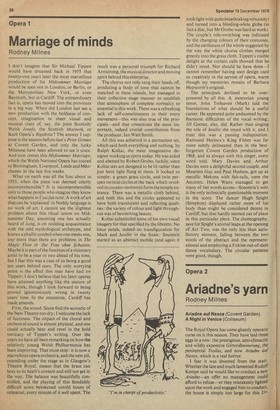Opera 1
Marriage of minds
Rodney Milnes
I don't imagine that Sir Michael Tippett would have dreamed back in 1955 that twenty-one years later the most marvellous production of his Midsummer Marriage would be seen not in London, or Berlin, or the Metropolitan New York, or even Bayreuth,' but in Cardiff. The extraordinary fact is, opera has moved into the provinces in a big way. When did London last see a new production with the boldness of concept, imagination or sheer visual and musical class of, say, the joint Scottish/ Welsh Jenufa, the Scottish Macbeth, or Kent Opera's Rigoletto? The answer I suppose is the season-before-last's Peter Grimes at Covent Garden, and only the lucky Milanese have been allowed to see it since. And now comes this Midsummer Marriage, which the Welsh National Opera has toured to Birmingham, Liverpool, Leeds and Manchester in the last five weeks.
What on earth was all the fuss about in 1955, when the piece was deemed utterly incomprehensible? It is incomprehensible only to those people who imagine they know what happens in Cosi fan mite. A work of art that can be 'explained' in Noddy language is no work of art. I cannot see the slightest problem about this ritual union on Midsummer Day, assuming one has actually heard of Jung, is on nodding acquaintance with the odd mythological archetype, and knows a phallic symbol when one meets one, any more than there are problems in The Magic Flute or Die Frau ohne Schutten. Maybe it is part of the function of a visionary artist to be a year or two ahead of his time, but I fear this was a case of us being a good ten years behind ours. The only worrying point is the .effect this may have had on Tippett ; I don't believe that his later operas have attained anything like the stature of this work, though I look forward to being proved ignominiously wrong in twenty years' time. In the meantime, Cardiff has made amends.
First, the sound. Some find the acoustic of the New Theatre too dry; I welcome the lack of fuzziness. The impact of the choral and orchestral sound is almost physical, and one could actually hear and revel in the bold intricacy of Tippett's writing. Over the years we have all been remarking on how the relatively young Welsh Philharmonia has been improving. That must stop: it is now a marvellous opera orchestra, and the new pit, extending under the stage as in Glasgow's Theatre Royal, means that the brass can bray to its heart's content and still not get in the way. The balance was beautifully controlled, and the playing of this fiendishly difficult score betokened untold hours of rehearsal, every minute of it well spent. The result was a personal triumph for Richard Armstrong, the musical director and moving spirit behind this enterprise.
The chorus not only sang their heads off, producing a body of tone that cannot be matched in these islands, but managed in their collective stage manner to establish that atmosphere of complete normalcy so essential in this work. There was a refreshing lack of self-consciousness in their every movement—this was also true of the principals—and that constitutes the most important, indeed crucial contribution from the producer, Ian Watt Smith.
All this was achieved in a permanent set, which said both everything and nothing, by Ralph Koltai, the most imaginative designer working in opera today. He was aided and abetted by Robert Ornbo, luckily, since Koltai sets are designed to be lit rather than just have light flung at them. It looked so simple: a green grass circle, and twin perspex vertical circles at the back which revolved in counter-motion to form the temple entrance. There was a metallic cloth behind, and both this and the circles appeared to have both translucent and reflecting qualities: the variety of colour and light throughout was of bewitching beauty.
Koltai substituted some of his own visual imagery for that specified by the libretto. No lotus petals, indeed no transfiguration for Mark and Jenifer in the finale : Sosostris started as an abstract mobile (and again it took light with quite breathtaking virtuosity) and turned into a blinding-white globe (in fact a disc, but Mr Ornbo was hard at work). The couple's role-switching was indicated by the changing colours of their costumes, and the earthiness of the whole suggested by the way the white chorus clothes merged greenly into the grass cloth. Tippett's visible delight at the curtain calls showed that he didn't mind. Nor should he have done—I cannot remember having seen design used so creatively in the service of opera, warm though my memories remain of Barbara Hepworth's original.
The principals declined to be overpowered by all this. A stentorian young tenor, John Treleaven (Mark) laid the foundations of what should be a useful career. He appeared quite undaunted by the fearsome difficulties of the vocal writing; Jill Gomez, alas, did. Rather than singing the role of Jenifer she toyed with it, and I trust this was a passing indisposition. Raimund Herincx's King Fisher was far more subtly delineated than in the bestforgotten Covent Garden production of 1968, and as always with this singer, every word told. Mary Davies and Arthur Davies were a delightful second couple, and Maureen Guy and Paul Hudson, got up as metallic Mekons with fish-tails, were the Ancients. Helen Watts managed to get many of her words across—Sosostris's solo is the only technically questionable moment in the score. The dancer Hugh Spight (Strephon) displayed rather more of his body than might be considered decent in Cardiff, but that hardly seemed out of place in this particular piece. The choreography, save for Spight's animal leaps at the opening of Act Two, was the only less than satisfactory element, falling between the two stools of the abstract and the representational and employing a Fokine out-of-date dance vocabulary. The circular patterns were good, though.














































 Previous page
Previous page